Introduction
As we will see later, although the EOS 1100D uses different and more recent hardware, its metrics are hardly improved. But before examining the details, we will spend some time analyzing not just how the new Rebel stands on the shelves against the fierce competition of the Nikon D3100 and the Sony SLT Alpha 33, but also against another category entirely: large-sensor mirrorless cameras such as the Sony NEX 5, which may be a real threat to the entry-level DSLR segment.
Compared to Nikon D3100 & Sony SLT A33
How does the EOS 1100D stand against its main competitors, the Nikon D3100 and the Sony SLT Alpha 33?
In short—not bad!
Compared to the Sony SLT A33, the EOS 1100D might seem handicapped against Sony and its very good 14-megapixel Exmor R sensor, which has a much better dynamic range than those of the D3100 and the EOS 1100D at low ISO settings. Up to ISO 400, Sony tops them all. But Sony’s new secret weapon, translucent mirror technology, perturbs light transmission, so as soon as we go above ISO 400, the EOS 1100D and D3100 overtake the SLT A33.
Translucent mirror technology also impacts the low-light performance of Sony’s entry-level Alpha 33, whose Sports score reaches its maximum at 591 ISO, while the EOS 1100D can go up to 755 ISO. The king of the hill for this specific metric, however, is the D3100 with a solid 919 ISO. The Sports score aims at finding how high the ISO sensitivity can be pushed while the sensor produces an image remaining above 30dB SNR, 9EV dynamic range, and 18-bit color depth, which means a very good-quality photo.
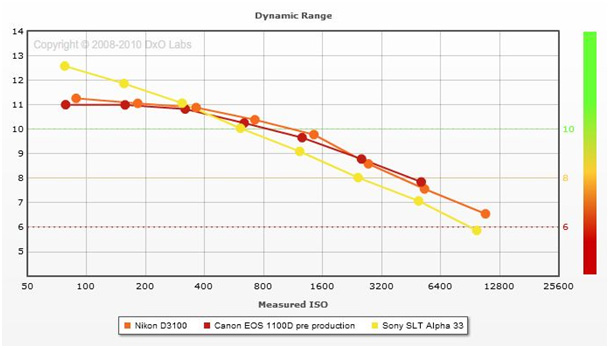
The EOS 1100D produces almost the same metrics as the Nikon D3100. Its SNR is as good as Nikon’s, and is slightly above Sony’s. The tonal range measurement shows the same results.
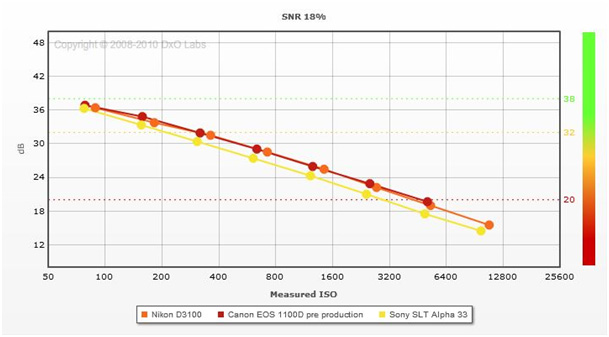
The color sensitivity metrics confirm the Sony A33’s slowing down at ISO 400, while Nikon D3100 proves a bit better. The EOS 1100D lies right in between those two sensors, with just a tiny difference, which is quite good.
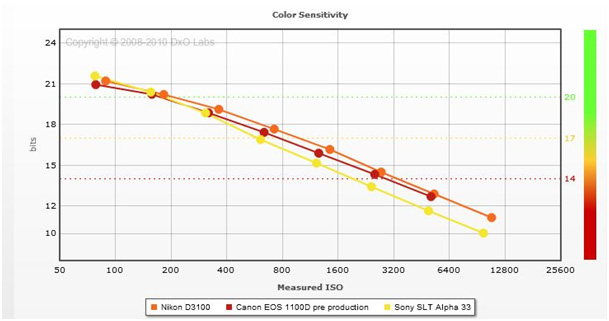
To sum up: The Alpha 33 is very good at low ISO settings, but as soon as we reach ISO 400, the 1100D produces less noise and better colors and continues to show very good behavior up to ISO 800.
The slightly more expensive Nikon D3100 proves a tiny bit better for almost the entire metric, but the difference is slight. This means that features such as the video recording function could give the Nikon a decisive advantage over the EOS 1100D.
The Full SNR analysis explains everything!
Let’s say a few words about the particular shape of Canon’s Dynamic Range curve. Below ISO 400, it is almost horizontal (just as with the D3100, by the way). And this reveals a problem. In order to identify it clearly, let’s have a look at the Full SNR graph:
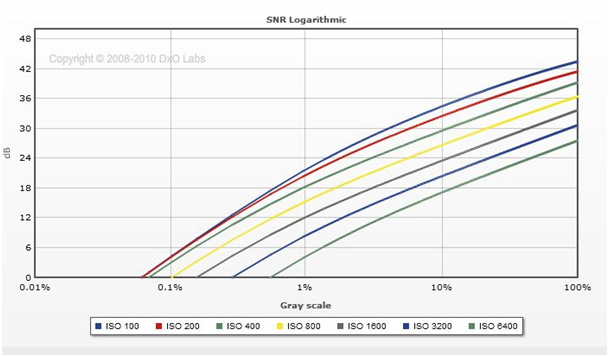
The different curves should not overlap or be too close. On the left side of the graph (representing the dark tones), the ISO 100 and 200 curves are superimposed, and the ISO 400 curve is very close. This explains the recurrent constant noise noticed in the dark zones at low ISO sensitivity. This also explains the flatness of the Dynamic Range curve below ISO 400, and also what prevents the EOS 1100D sensor to have a better SNR metric at low ISO settings. This is also a problem for the Nikon D3100.
The dynamic range of the Alpha 33 is much better than that of the two other sensors, and its full SNR shows why: its curves are much better.
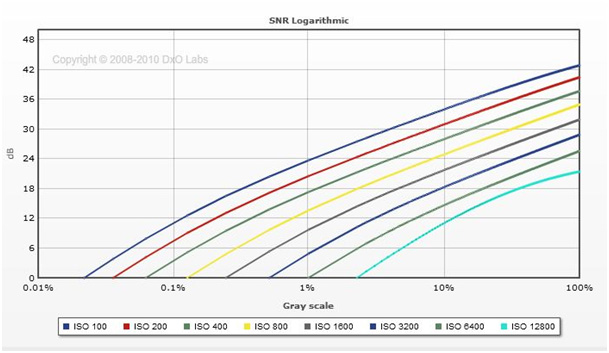
View Nikon D3100 vs Sony SLT A33 vs Canon EOS 1100D
Compared to Sony NEX 5: High-end mirrorless or entry-level DSLR?
Entry-level APS-C bodies are strongly challenged by APS-C mirrorless compact cameras. Same sensor, smaller form factor, same price point… life on the dealer’s shelves is not so easy for entry-level DSLR today! Let’s compare the EOS 1100D metrics to those for the Sony NEX 5 to make things clear.
And the results are clear. Leveraging on a good 14-megapixel Exmor R sensor, the NEX 5 produces solid DSLR-like metrics in all the tested fields. It manages to outperform the EOS 1100D, although by just a little bit. Better Overall score, better Portrait score, better Landscape score, and better Sports score… the NEX 5 takes it all.
However, the main difference lies in Dynamic Range, where the NEX 5 is almost 1 EV ahead at ISO 400 and below, and stays above the EOS 1100D up to ISO 800. Once again Canon is handicapped by its low-ISO noise production in the darkest zones (as indicated by the full SNR chart analysis).
Thus it is clear that the fierce competition of the large sensor mirrorless cameras will make it hard for this entry-level DSLR: similar or better performance, same price point (the NEX 5 is only $50 more), interchangeable lenses, and a better video function. Can Canon avoid producing an APS-C mirrorless camera and still remain competitive?
View Sony NEX 5 vs Canon EOS 1100D
Compared to EOS 1000D: Improvement?
Comparing the EOS 1100D to the EOS1000D reveals very few differences. The Overall score for both bodies is similar (62), as are the scores for Portrait and Landscape. Thus at first sight, if the technical recipe used to build the EOS 1100D is different, it has had very little impact on the metrics.
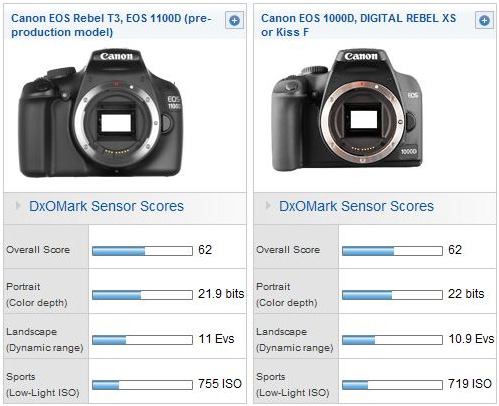
The only point for which the 1100D shows a slight difference is its low-light ISO score, improving the metric by 36 ISO.
When the detailed metrics are analyzed, the similarity is more than obvious. The SNR is almost identical, and so is the tonal range measurement.
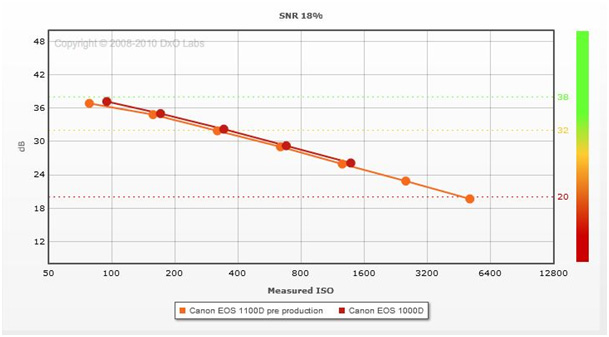
A few differences are noticeable in the dynamic range analysis, in which the 1100D behaves better than the 1000D at ISO 400 and higher.
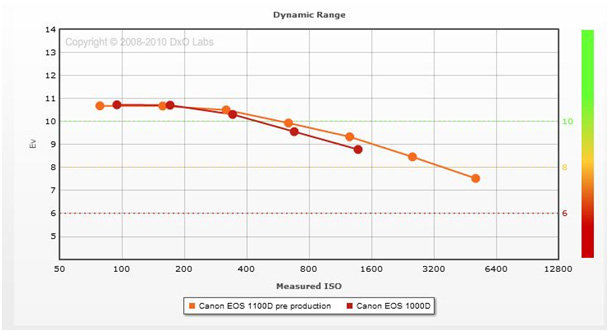
But on the other hand, the EOS 1100D ranks below its predecessor where color sensitivity is concerned, with a curve steadily below that of the 1000D. However, we measured these metrics using a preproduction sample. This might explain the performance, although the sensor in the EOS 450D (similar to that of the EOS 1100D) has exactly the same color sensitivity metrics as those of the EOS 1100D.
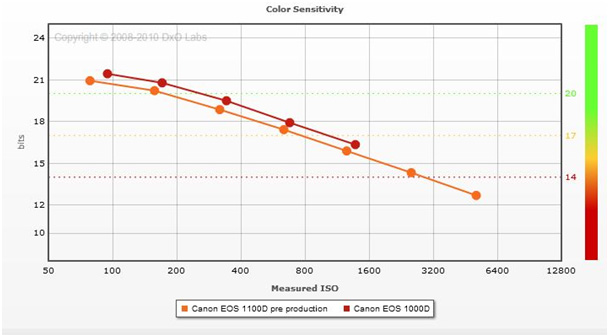
So the EOS 1100D sensor doesn’t have much greater quality than its predecessor. It is a bit better in low-light conditions, but just barely. The main differences are the increase in definition, the use of 14 bits per pixel coding instead of 12, and the movie function implemented in the camera.
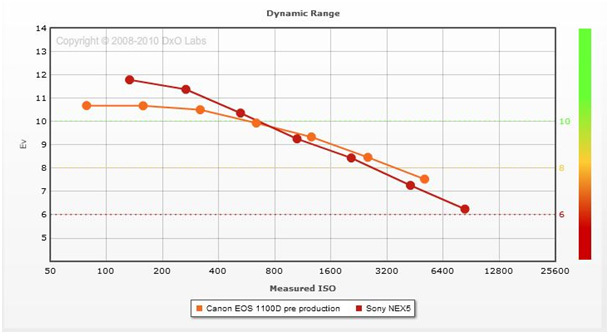
Similarly, the color sensitivity measured on the NEX 5 sensor is 1 bit better than that for the EOS 1100D below ISO 800.
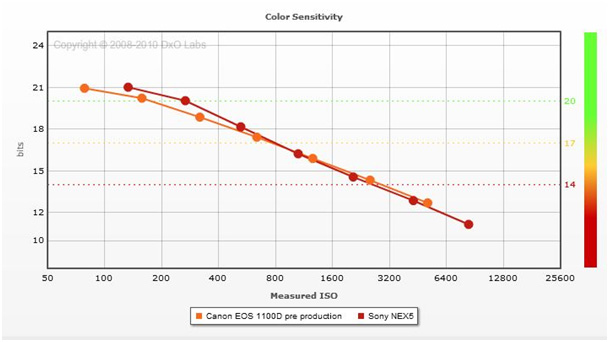
These metrics indicate that although the hardware basis has changed, the still-picture performance has not. Or not much. —Which means that the most noticeable difference between the old and new generations are to be found directly on the spec sheet: better definition and video recording capability.
View Canon EOS 1000D vs Canon EOS 1100D
Conclusion
The Canon EOS 1100D looks pretty much like a revamping of the EOS 1000D, adding video and a few more pixels on the sensor—a must-have for today’s DSLRs. But these changes have almost no impact on the image quality. Competing DSLRs such as the D3100 offer better features (better video recording capability), and others such as the Alpha SLT 33 deliver better metrics, helped by a much better dynamic range at low ISO. Leaving the store shelves won’t be so easy for the EOS 1100D.
But the fast-growing mirrorless segment, pushed by Sony Nex 5, will certainly be the most dangerous threat to these entry-level DSLRs, adding the smaller form factor to better image quality and solid video features.


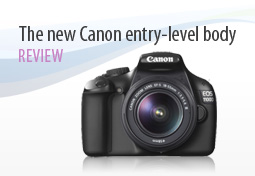


DXOMARK encourages its readers to share comments on the articles. To read or post comments, Disqus cookies are required. Change your Cookies Preferences and read more about our Comment Policy.